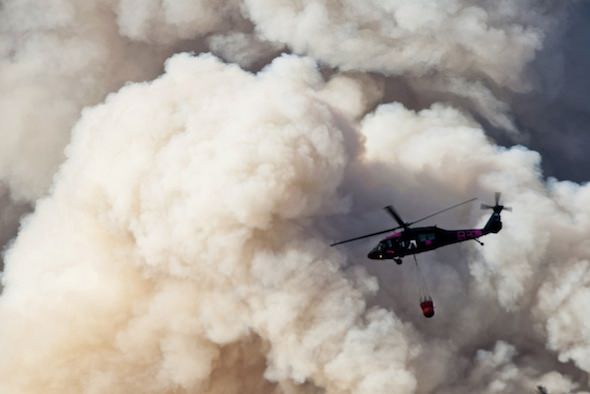Western U.S. Faces Worsening Wildfires
Drought and warmth are expected to mark winters in the Western U.S., researchers say, while abnormally cold weather will make the East and Southeast unusually wintry.
By Tim Radford, Climate News NetworkThis piece first appeared at Climate News Network.
LONDON — Wildfires in the western United States are getting worse. In the last 30 years they have become both bigger and more frequent, according to a new study in Geophysical Research Letters.
Philip Dennison of the University of Utah and colleagues found that the number of wildfires that burned more than 1,000 acres (405 hectares) increased at the rate of seven fires a year between 1984 and 2011, over an area stretching from Nebraska to California. The total area left smouldering each year increased on average by 355 square kilometres.
The trend is linked to climate change and the implication is that it is likely to become more severe in the coming decades. “We looked at the probability that increases of this magnitude could be random and in each case it was less than 1%,” said Dr Dennison.
The researchers used satellite data to measure areas destroyed, and matched the evidence against seasonal temperatures and rainfall over the same period. Most areas that saw more fires were also likely to have experienced increases in drought during the same time.
That the US west has been hit by severe drought and has been ravaged by wildfire is hardly news. The connection between drought and wildfire is not straightforward: changes in forest management practices, for instance, could explain some of the increase. In some ecosystems, fire is part of the natural cycle of growth, death and regeneration.
Climate-driven impact
But on balance, high temperatures and sustained drought tend to increase the risk of fire, and the Utah study is the first to make a point of looking at the evidence over nine different ecological regions – mountain forests, warm deserts, grasslands.
Last year, researchers found evidence of an historic increase in wildfire in Alaska, an increase also linked to a pattern of regional warming associated with a build-up of carbon dioxide in the atmosphere.
And a second piece of research suggests that the pattern of heat and drought in the west, and winter ice storms in the east of the US, began a long time ago and is likely to continue.
Scientists from Utah, California, Alaska, Ohio, Japan and China report in Nature Communications that an analysis of oxygen isotope ratios in lake sediments and cave deposits across the US and Canada yielded a picture of temperature patterns, and of changes to the jet stream that brings winter weather to the North American continent, over an 8000-year period.
A trend for warm dry winters in the west and fierce extremes of cold in the east of the US seems to have set in about 4000 years ago and may increase as global average temperatures rise.
Reluctant to pay
“A sinuous or curvy jet stream means unusual warmth in the west, drought conditions in part of the west, and abnormally cold winters in the east and south-east,” said Gabriel Bowen of the University of Utah.
Human-caused climate change is reducing the temperature differences between the equator and the poles, with the polar regions becoming warmer. This tends to make the phenomenon of a sinuous jet stream more frequent, or more intense, or both, which means more extremes of weather in winter in the east, and unseasonal drought or warmth in the west.
Although ice storms, drought, wildfires and hurricanes have cost US residents dearly, public attitudes still present a puzzle. Four months after Hurricane Sandy brought unparalleled levels of flooding and destruction to the New York region in October 2012, scientists at Rutgers University in the US conducted a survey of opinion among 875 residents of New Jersey, which saw some of the worst of the devastation.
The scientists report in the journal Risk Analysis that they found strong support for government policies to reduce the likelihood of damage from future hurricanes. A majority agreed that climate change presented a risk to them and their families.
However, only about one in five of those surveyed were prepared to contribute to a fund, or pay increased state sales taxes, or agree to an extra tax on gasoline sales to pay for mitigation. Four out of five were strongly opposed to this idea.
Your support matters…Independent journalism is under threat and overshadowed by heavily funded mainstream media.
You can help level the playing field. Become a member.
Your tax-deductible contribution keeps us digging beneath the headlines to give you thought-provoking, investigative reporting and analysis that unearths what's really happening- without compromise.
Give today to support our courageous, independent journalists.









You need to be a supporter to comment.
There are currently no responses to this article.
Be the first to respond.